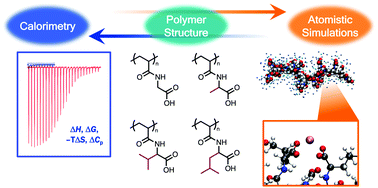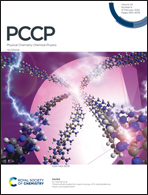Exploring the role of polymer hydrophobicity in polymer–metal binding thermodynamics†
Abstract
Metal-chelating polymers play a key role in rare-earth element (REE) extraction and separation processes. Often, these processes occur in aqueous solution, but the interactions among water, polymer, and REE are largely under-investigated in these applications. To probe these interactions, we synthesized a series of poly(amino acid acrylamide)s with systematically varied hydrophobicity around a consistent chelating group (carboxylate). We then measured the ΔH of Eu3+ chelation as a function of temperature across the polymer series using isothermal titration calorimetry (ITC) to give the change in heat capacity (ΔCP). We observed an order of magnitude variation in ΔCP (39–471 J mol1 K−1) with changes in the hydrophobicity of the polymer. Atomistic simulations of the polymer–metal–water interactions revealed greater Eu3+ and polymer desolvation when binding to the more hydrophobic polymers. These combined experimental and computational results demonstrate that metal binding in aqueous solution can be modulated not only by directly modifying the chelating groups, but also by altering the molecular environment around the chelating site, thus suggesting a new design principle for developing increasingly effective metal-chelating materials.



 Please wait while we load your content...
Please wait while we load your content...